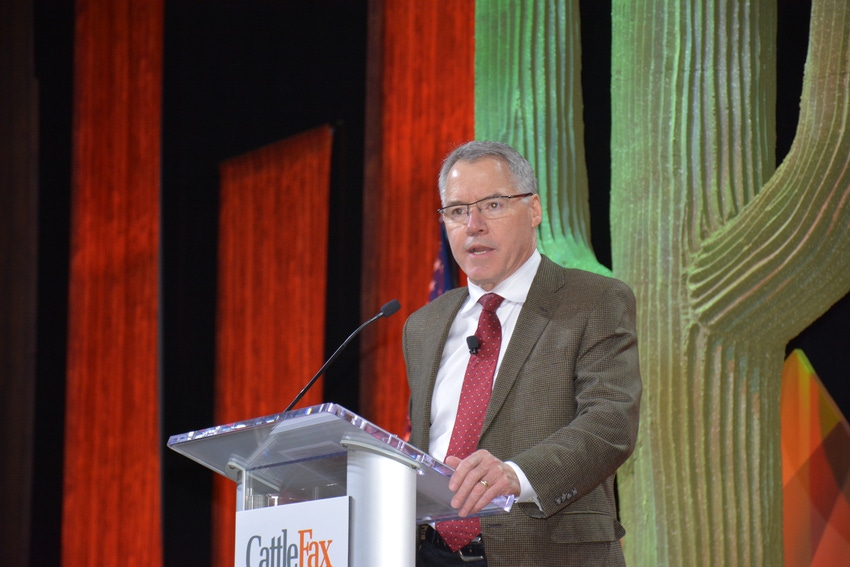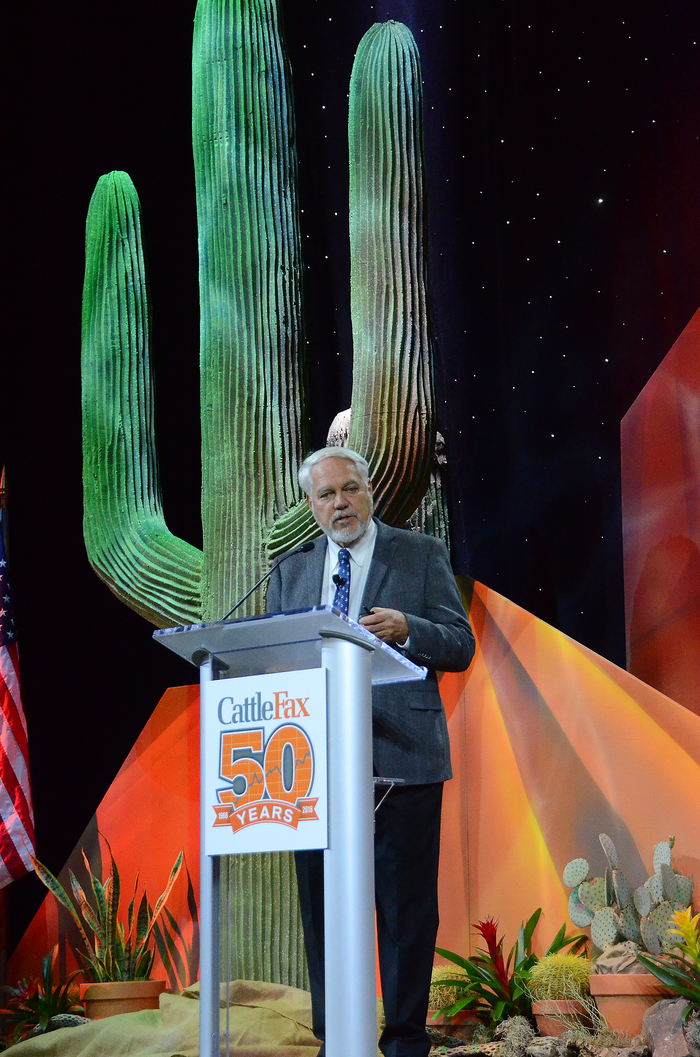More volatility. More beef production. More dry weather in the Southwest. But it wasn't all more of the same in the CattleFax Outlook session. There are some changes on the horizon in 2018.
February 2, 2018

“We think 2018 will be a profitable year for most,” said Randy Blach, CattleFax CEO, at that organization’s 2018 Industry Outlook during the Cattle Industry Convention in Phoenix, Ariz. “Demand means calf prices might not fall below the cost of production for average-cost and low-cost producers.”
The latter point applies to the current year and cattle cycle.
Although cyclical risk remains, Blach added that the majority of the price break is already in the books. Keep in mind that industry profit last year was the second most in history, according to CattleFax.
CattleFax projects the price for a 550-pound steer calf this year at $135-$180 per cwt; an average of $158, which is $7 less than last year. The price for a 750-pound steer is estimated at $135-$160; an average of $145, which is $1 less. The fed steer price is projected at $110-$130; $115 average, which would be $6 less than last year.
That’s all the more impressive when you consider anticipated record-large total red meat and poultry production for the next several years.
‘We’ll peak at about 3 million more beef cows than the last low, growing harvest numbers through the rest of the decade, “Blach says.
More specifically, CattleFax projects beef production this year 3% more than last year at 27.5 billion pounds, ultimately peaking at more than 29 billion pounds for the cycle. This year’s estimate is based on projections of fed slaughter of 26.6 million head, which would be 3% more than last year.
CattleFax estimates the average cold carcass weight this year at 822 pounds, which would be 10 pounds more than last year, but still 3 pounds less than in 2016.
Price strength stems from robust domestic demand and growing international demand for beef.
CattleFax expects the Annual U.S. Retail Beef Demand Index to be stable this year at 121 (it was 123 in 2016). Analysts there note that recent tax reform and expected GDP growth of 2-4% provides demand support. At the same time, they expect interest rates to increase 1.00-1.25% this year.
Globally, CattleFax looks for U.S. beef exports to increase 6% this year to 3 billion pounds.
“The balance of trade improved by 1 billion pounds between 2015 and 2017, offsetting 40% of the production growth,” says Kevin Good, CattleFax senior analyst. He adds the balance of trade should remain positive this year, though likely not as strong as last year.
“We have to see these exports grow,” Blach says. “We’ll need to see record export numbers through the balance of the decade to keep supplies from overwhelming the market.” He adds that overall demand will be the key to maintaining fed cattle prices in the $100 area through 2020.
Primary short-term uncertainties
The main wildcard this year is weather.

Art Douglas
CattleFax meteorologist, Art Douglas, points to the current La Niña, which has wrought significant drought across two-thirds of the nation.On the one hand, forecasts through the spring and summer call for continued hotter and drier conditions across much of the West and Southern Plains. On the other, Douglas notes various current weather events point to La Niña weakening heading into summer with a new El Niño potentially forming to bring some relief heading into fall.
Already, hay stocks are the snuggest since 1976 (except for 2012-13) CattleFax analysts say. “Expect hay prices to increase $15-$20 per ton, with additional weather-related risk.”
The depth and length of drought will have plenty to say about whether the nation’s beef cowherd continues to expand, and if so, by how much.
As it is, according to the CattleFax Outlook, the U.S. beef cowherd grew by 2.8 million head over the last four years.
For reference, there were 31.72 million beef cows to start this year, according USDA’s recent Cattle inventory report. That’s 509,800 head more (+1.63%) than Jan. 1, 2017.
CattleFax analysts say additional expansion of 200,000-400,000 beef cows is possible over the next several years—a plateau in 12-18 months—leading to a herd size still short of the 32.7 million in 2006.
“Industry numbers rebounded due to good grazing conditions and profitability,” Good says. While profitability continues, drought conditions serve as a headwind.
Historic volatility to continue
Blach highlighted feedlot profits and losses in recent years as an illustration of now commonplace extreme price volatility.
Using a simple average and assuming no risk management: feedlot profits were $4.5 billion in 2014; losses were $6.5 billion in 2015-16; profits were $4 billion last year.
Further, Balch points to price swings of $40 per cwt ($550 per head) for fed cattle, from highs to lows during the past three years. Shorter term, he says it’s common to see daily cash fed cattle prices move $14-$18 per cwt within two or three weeks.
“These equity swings are unprecedented and the reason risk management has increased,” Blach says. “We think this will continue. We think we’ll have more price volatility than at any time in the past.
About the Author(s)
You May Also Like





